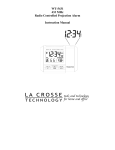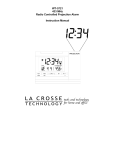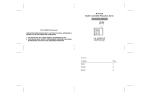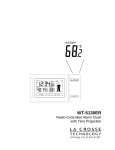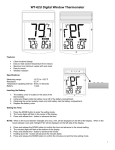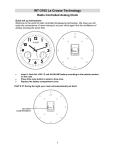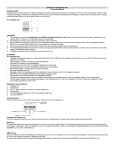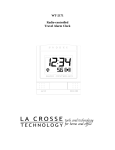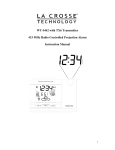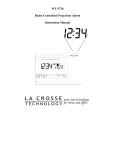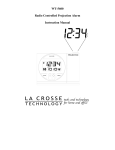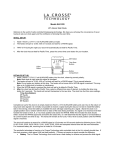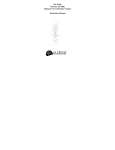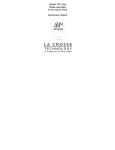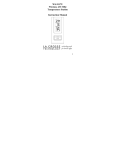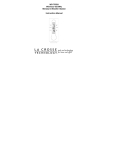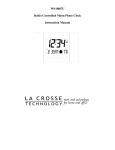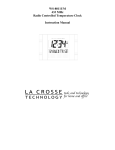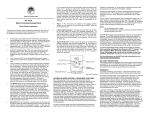Download La Crosse Technology WT-5120 433 User's Manual
Transcript
WT-5120 433 MHz Radio Controlled Projection Alarm Instruction Manual TABLE OF CONTENTS Topic Inventory of Contents/ Additional Equipment About WWVB Quick Set-Up Guide Page 3 3 4 Detailed Set-Up Guide Battery Installation Program Mode Programming Sequence Function Buttons Manual Time Setting Time Zone Setting Daylight Saving Time (DST) Setting 6 6 6 6-7 7 Features & Operations Features Radio-Controlled Time Projection EL Backlight Indoor Temperature Indoor Humidity Remote Temperature Time Alarm Changing Display Mode Mounting Maintenance & Care Troubleshooting Specifications Warranty and Contact Information 8 8 8 9 9 9 9 10 10 11 11 12 13 14-15 5 2 INVENTORY OF CONTENTS 1) WT-5120 Alarm Clock 2) TX6U Remote temperature sensor 3) AC adapter/transformer 4) Instruction manual and warranty card. ADDITIONAL EQUIPMENT (not included) 1) Two fresh 1.5V AA batteries (optional for projection alarm clock) 2) Two fresh 1.5V AA batteries (for remote temperature sensor) FEATURES OF PROJECTION ALARM Operation of these features is in section III 1. 2. 3. 4. 5. 6. 7. Radio-controlled time Projection of time and/or remote temperature EL backlight Display of indoor temperature/humidity or alarm time Indoor temperature and humidity Remote outdoor temperature Time alarm ABOUT WWVB (Radio Controlled Time) The NIST (National Institute of Standards and Technology—Time and Frequency Division) WWVB radio station is located in Ft. Collins, Colorado, and transmits the exact time signal continuously throughout the United States at 60 kHz. The signal can be received up to 2,000 miles away through the internal antenna in the projection alarm. However, due to the nature of the Earth’s Ionosphere, reception is very limited during daylight hours. The projection alarm will search for a signal every night when reception is best. The WWVB radio station receives the time data from the NIST Atomic clock in Boulder, Colorado. A team of atomic physicists is continually measuring every second, of every day, to an accuracy of ten billionths of a second per day. These physicists have created an international standard, measuring a second as 9,192,631,770 vibrations of a Cesium-133 atom in a vacuum. For more detail, visit http://www.boulder.nist.gov/timefreq.htm. To listen to the NIST time, call (303)499-7111. This number will connect you to an automated time, announced at the top of the minute in “Coordinated Universal Time”, which is also known as Greenwich Mean Time (GMT). This time does not follow Daylight Saving Time changes. After the top of the minute, a tone will sound for every second. It is possible that your projection alarm may not be exactly on the second due to the variance in the quartz. However, the clock will adjust the quartz timing over the course of several days to be very accurate; under 0.10 seconds per day. 3 QUICK SET-UP GUIDE Hint: Use good quality Alkaline Batteries and avoid rechargeable batteries. 1. Have the projection alarm and remote temperature sensor 3 to 5 apart. 2. Batteries should be out of both units for 10 minutes. 3. Place the batteries into the remote temperature sensor first then into the projection alarm. 4. DO NOT PRESS ANY BUTTONS FOR 15 MINUTES. In this time the display and sensor will start to talk to each other and the display will show both the indoor temperature/humidity and an outdoor temperature. If the station does not display both temperatures and indoor humidity after the 15 minutes please retry the set up as stated above. After both indoor and outdoor temperatures are displayed for 15 minutes you can place your sensor outdoors and set your time. The remote sensor should be placed in a dry, shaded area. The remote sensor has a range of 80 feet. Any walls that the signal will have to pass through will reduce distance. An outdoor wall or window will have up to 20 feet of resistance and an interior wall will have up to 10 feet of resistance. Your distance plus resistance should not exceed 80 ft. in a straight line. NOTE: Fog and mist will not harm your remote sensor but direct rain must be avoided. To complete the set up of your temperature station after the 15 minutes have passed please follow the steps beginning on page 6. 4 DETAILED SET-UP GUIDE II. BATTERY INSTALLATION A. B. REMOTE TEMPERATURE SENSOR 1. Remove the battery cover. 2. Observing the correct polarity, install 2 AA batteries. The batteries will fit tightly (to avoid start-up problems make sure that they do not spring free during installation). 3. Replace the battery cover. Battery Cover PROJECTION ALARM 1. Remove the battery cover. 2. Observe the correct polarity, and install 2 AA batteries. 3. In addition or instead of inserting batteries, the AC adapter can be used. Simply plug the adapter into the receptacle on the underneath of the alarm clock and then plug in adapter. 4. Replace the battery cover. 5. The projector will activate and remain on if the alarm clock is plugged in. If only batteries are used, the projector will only be activated when a button is pressed. The projection is a red light, not harmful under normal usage, AC adapter although care should be taken to not look receptacle directly into the light. Notes: • After the batteries have been installed a tone will sound, and the LCD (Liquid Crystal Display) will activate. • The indoor temperature/humidity and the remote temperature will be displayed. Also, the time will appear as “-:--”. • The WWVB search is automatically initiated, and a tower icon appears and flashes with the time colon (no tower icon will appear if the WWVB is too weak to be detected, and the time display will remain on “-:--”). • While the WWVB search is being conducted various numbers will appear in the time display. • After 15 minutes, the projection alarm will either display the WWVB time, or discontinue the search if the time is not found. If the search is cancelled “-:--” will remain in the time LCD. • The projection alarm will conduct a WWVB search every hour until the first signal is found. • Once the WWVB time is found, a search is automatically conducted nightly at midnight. • If the signal is found at midnight, the tower icon will remain, if not, another search will take place every hour (until 6:00 am) until the signal is found successfully. • If no signal is found during this period, the tower icon will not appear and the clock will search again at 12:00 am the next night. • The radio-controlled time receiver is located on the bottom side of the projection alarm. When using the AC adaptor be sure to keep the adapter cord away from the bottom side of the unit as if the wire is too close it can cause weakened reception sensitivity. 5 III. PROGRAM MODE To enter the Program Mode hold down the “MODE/MIN” button for 3 seconds, until the time flashes in the top of the display. The Program Mode Guide is laid out in a manner that allows you to program each function separately, or you can follow the instructions entirely to program the projection alarm. Complete programming is usually done for the initial set-up, and will require you to skip step 1 and 2 of programming sections D and E. To exit the setting mode simply wait approximately 10 seconds for the projection alarm to automatically return to normal operation. A. PROGRAMMING SEQUENCE 1. 2. 3. B. Manual Time Display Time Zone Setting Daylight Saving Time On/Off FUNCTION BUTTONS There are 3 function buttons located on the front of the projection alarm and one on the top. The function buttons are labeled: AL/HOUR, light direction icon, MODE/MIN, and SNOOZE (the top bar). Alarm Button (also adjusts the hours in time setting mode) C. Display Direction Mode Button (toggles between indoor temp/hum and alarm time. Also adjusts minutes in time setting mode MANUAL TIME SETTING 1. 2. Hold down the “MODE/MIN” button for 3 seconds, the time will flash in the Time LCD. Press and release the “AL/HOUR” button to advance the hours and press and release the “MODE/MIN” button to advance the minutes. NOTE: “A.M.” or “P.M.” will be displayed to the left of the time to help identify the time. 3. D. Press and release the “SNOOZE” button to confirm the time setting and to advance to DST (Daylight Saving Time) setting. TIME ZONE SETTING 1. 2. 3. Hold down the “MODE/MIN” button for 3 seconds, the time will flash in the Time LCD. Press and release the “SNOOZE” button to advance to the time zone selection. In the indoor temperature/humidity section of the LCD the time zone will flash. 6 4. Press and release the “MODE/MIN” button to select the appropriate time zone. There are 24 time zones to choose from (based relative to the international time standard of GMT (“Greenwich Mean Time). NOTE: The U.S. time zones will show abbreviations as opposed to the numerical time zone indicator. For example Eastern Time will display “ET” when the Eastern Time Zone is selected 5. Press and release the “SET” button to confirm the time zone setting and to advance to the DST (Daylight Saving Time) setting. -4h -5h -6h -7h -8h -9h -10h -11h, -12h 0h -1h, -2h, -3h E. Atlantic Time Eastern Time (default setting) Central Time Mountain Time Pacific Time Alaskan Time Hawaiian Time Next two time zones West of HAW Greenwich Mean Time Three time zones West of GMT DST (DAYLIGHT SAVING TIME) SETTING Note: The DST default is “On”, meaning that the WWVB will automatically change the time according to Daylight Saving Time in the spring and fall. For areas that do not recognize DST changes (Arizona and parts of Indiana) turn the DST “OFF”. 1. 2. 3. 4. 5. Hold down the “MODE/MIN” button for 3 seconds, the time will flash in the Time LCD. Press and release the “SNOOZE” button twice to advance to the DST setting. “DST” will appear in the indoor temperature/humidity LCD and “ON” or “OFF” will flash in the time LCD. Press and release the “MODE/MIN” button to toggle between DST ON and OFF.. Press and release the “SNOOZE” button to confirm the DST setting and complete the set-up sequence. 7 IV. FEATURES & OPERATIONS A. FEATURES 1. 2. 3. 4. 5. 6. 7. Radio-controlled time Projection of time and/or remote temperature LED backlight Display of indoor temperature/humidity or alarm time Indoor temperature and humidity Remote outdoor temperature Time alarm B. RADIO-CONTROLLED TIME 1. The projection alarm will automatically search for the time signal upon initial set-up and every night. 2. When the signal is being received, there will be a “tower” icon flashing to the left of the time display. 3. When the time signal has been received successfully, the tower icon will remain steady until midnight. 4. The NIST (National Institute of Standards and Technology—Time and Frequency Division) WWVB radio station is located in Ft. Collins, Colorado, and transmits the exact time signal continuously throughout the United States at 60 kHz. The signal can be received up to 2,000 miles away through the internal antenna in the projection alarm. 5. Due to the nature of the Earth’s Ionosphere, reception is very limited during daylight hours. The projection alarm will search for a signal every night when reception is best. 6. The WWVB radio station receives the time data from the NIST Atomic clock in Boulder, Colorado. A team of atomic physicists is continually measuring every second, of every day, to an accuracy of ten billionths of a second per day. These physicists have created an international standard, measuring a second as 9,192,631,770 vibrations of a Cesium-133 atom in a vacuum. 7. For more detail, visit http://www.boulder.nist.gov/timefreq.htm. To listen to the NIST time, call (303) 499-7111. This number will connect you to an automated time, announced at the top of the minute in “Coordinated Universal Time”, which is also known as Greenwich Mean Time (GMT). This time does not follow Daylight Saving Time changes. After the top of the minute, a tone will sound for every second. 8. It is possible that your projection alarm may not be exactly on the second due to the variance in the quartz. However, the clock will adjust the quartz timing over the course of several days to be very accurate; under 0.10 seconds per day. C. PROJECTION OF TIME AND REMOTE TEMPERATURE 1. 2. 3. 4. 5. 6. When plugged into an AC outlet, the projection alarm will continuously project the time and remote temperature. When operating on batteries alone, the projection alarm will only project when the snooze button is pressed or the alarm is sounding. The projection will auto-focus for display from three to six feet away. A dark surrounding will be necessary to clearly see the projection. The projection alarm will automatically toggle between the time and outdoor temperature when projecting; either when the “SNOOZE” button is pressed or continuously when using the AC adaptor. The direction of the display can also be rotated 360° in 90° increments by pressing the directional button. There is no display on the LCD that signifies the direction. The projector case can be rotated 180° to further help orient the projected display. 8 D. EL BACKLIGHT 1. 2. E. INDOOR TEMPERATURE 1. 2. 3. 4. F. The projection alarm measures indoor temperature with an internal sensor. This temperature is displayed in °F. The indoor temperature will take time to adjust to the surrounding temperature as the sensor is inside the case. If the remote temperature is placed next to the projection alarm, more often than not the temperature will not be exact with one another. This is not a defect, but simply reflects the difference in measuring methods. The remote temperature is designed for changing temperature at a wide range. INDOOR HUMIDITY 1. 2. 3. G. The projection alarm has an EL backlight designed for night-viewing. This will light up for 4 seconds whenever the snooze button is pressed. The EL backlight cannot be turned on constantly; this would drain the batteries. The projection alarm measures indoor humidity with an internal sensor. This humidity is displayed as a percentage (%). The indoor humidity will take time to adjust to the surrounding humidity as the sensor is inside the case. REMOTE TEMPERATURE 1. 2. 3. 4. 5. 6. 7. The projection alarm comes with a remote temperature sensor. When set up properly, the projection alarm will receive and display the remote temperature. It is important to power up the sensor first, then the projection alarm. If batteries are removed in the remote, the projection alarm MUST be re-set by removing power sources and re-starting. The remote temperature is measured within the remote temperature and transmitted to the projection alarm. If outdoor temperature is desired, simply mount the remote sensor outside. It is recommended to mount the sensor on the North side of the house away from sources of heat or cold (away from direct sunlight, windows, vents, etc.). The range of the sensor is 80 feet in open space. While the signal is able to penetrate walls, it will decrease the range. Concrete and metal structures offer the most resistance. The sensor should not be mounted on a metal surface. The sensor and projection alarm should be kept away from other sources of possible interference including cordless appliances (telephones, baby monitors), microwave ovens, and other strong electrical appliances. The remote temperature is displayed in °F. 9 H. TIME ALARM 1. SETTING THE ALARM a. Press and hold “AL/HOUR” button for three seconds until the alarm time is flashing. b. Press and release “AL/HOUR” to advance the hour, and “MODE/MIN” to advance the minute. The time will display “PM” if set to PM, and nothing if set to AM. c. The projection alarm will revert to normal operation when no buttons are pressed for 15 seconds. The alarm is now set and activated. 2. ACTIVATING/DEACTIVATING THE ALARM a. After entering the alarm setting mode, the alarm is activated. b. To toggle between activating and deactivating the alarm, press the “AL/HOUR” button briefly. “(((○)))”will be displayed above the time display when the alarm is activated. 3. TURNING ALARM OFF (WHILE SOUNDING) a. While the alarm is sounding, press and release the “SNOOZE” bar to disable the alarm for 10 minutes. b. After the SNOOZE bar is pressed the alarm icon will flash. c. To disable the alarm for 24 hours, press and release any button other than SNOOZE or display direction buttons. NOTE: The alarm will sound for 84 seconds if the “SNOOZE” button is not pressed. The alarm speeds up twice, once after 20 seconds and again after 50 seconds. I. CHANGING DISPLAY MODE (INDOOR TEMPERATURE/HUMIDITY OR ALARM TIME) There are two possible display modes in the indoor temperature/humidity section of the LCD (lower left). To change the display press and release the “MODE/MIN” button to toggle between the two modes. 10 V. MOUNTING THE REMOTE TEMPERATURE SENSOR The remote temperature sensor can be mounted in two ways: 1) Using screws 2) Using the adhesive tape. A. MOUNTING WITH SCREWS 1. 2. 3. 4. 5. B. MOUNTING WITH ADHESIVE TAPE 1. 2. VI. Remove the mounting bracket from the remote temperature sensor. The bracket should snap off easily. Place the mounting bracket over the desired location. Through the three screw holes of the bracket, mark the mounting surface with a pencil. Where marked, start the screw holes into the mounting surface. Screw mounting bracket onto the mounting surface. Ensure that the screws are flush with the bracket. Snap the remote temperature sensor onto the mounted bracket. With a nonabrasive solution, clean and dry the back of the mounting bracket and the mounting surface to ensure a secure hold. The mounting surface should be smooth and flat. Remove the protective strip from one side of the tape. Adhere the tape to the designated area on the back of the mounting bracket. Remove the protective strip from the other side of the tape. Position the remote temperature sensor in the desired location, ensuring that the projection alarm clock can receive the signal. MAINTENANCE & CARE A. Extreme temperatures, vibrations, and shock should be avoided to prevent damage to the units. B. Clean displays and units with a soft, damp cloth. Do not use solvents or scouring agents— they may mark and damage the displays and casings. C. Do not submerge in water. D. Immediately remove all low powered batteries to avoid leakage and damage. E. Replace with new batteries only, and of recommended size. F. Opening the casings invalidates the warranty. Do not try to repair the units. Contact La Crosse Technology for Repairs. 11 TROUBLESHOOTING Problem: Solution: Problem: Solution: Problem: Solution: Problem: Solution: Problem: Solution: Problem: Solution: Problem: Solution: The Projection is faint 1) Use AC adapter 2) Darken surroundings 3) Use fresh batteries (if AC is not used) The LCD is faint. Replace the batteries. “OFL” appears in the indoor temperature LCD. 1) Move unit to an area with warmer or cooler surrounding temperature. 2) Current surrounding temperatures are outside measuring range. No reception of WWVB signal. 1) It may help reception to face the front of the projection alarm in the general direction of Ft. Collins, Colorado. 2) Wait overnight for signal. 3) Be sure the projection alarm is at least 6 feet from any electrical devices, i.e. TV sets, computers, or other radio controlled clocks. 4) Remove batteries for five minutes, reinsert and leave the unit alone overnight without pressing buttons. 5) If problems persist contact La Crosse Technology. Hour is incorrect (minute is correct). Be sure correct time zone and daylight saving time are selected. “--.-” appears in outdoor temperature LCD 1) Check batteries in remote 2) If batteries are replaced in remote, the unit must be re-started. Remove all batteries, and then follow start up procedure. “OFL” appears in the outdoor temperature LCD 1) Remote temperature is out of range. 2) Check batteries. 3) Interference from an outside source (cordless telephone, etc.) 4) Contact La Crosse Technology. Note: For any questions not answered, contact La Crosse Technology with the contact information found at the end of this instructional manual. 12 SPECIFICATIONS FOR WT-5120 Temperature: Measuring range: Checking intervals: Humidity: Measuring range: Checking intervals: Power source: AC Adapter (included) 14°F to 99°F with 0.2°F resolution (indoor) -21.8°F to 156.2°F with 0.2°F resolution (outdoor) Every 10 seconds indoor, 2 times in 10 minutes for remote temperature. 1 – 99 % Every 10 seconds Input: 120VAC/60Hz Output: DC 3.2V/100MA Battery type: Projection Alarm: 2 x AA, 1.5V (Alkaline) (optional) Sensor: 2 x AA, 1.5V (Alkaline) Battery life: Approximately 12 months, depending on projection and backlight use Dimensions (H x W x D): Projection Alarm Clock 3.5 x 5.5 x 2 in (90.6 x 140.3 x 48.5 mm) 5 x 1.5 x 1 in Remote Temperature Sensor (128 x 40 x 23 mm) 13 WARRANTY INFORMATION La Crosse Technology, Ltd provides a 1-year limited warranty on this product against manufacturing defects in materials and workmanship. This limited warranty begins on the original date of purchase, is valid only on products purchased and used in North America and only to the original purchaser of this product. To receive warranty service, the purchaser must contact La Crosse Technology, Ltd for problem determination and service procedures. Warranty service can only be performed by a La Crosse Technology, Ltd authorized service center. The original dated bill of sale must be presented upon request as proof of purchase to La Crosse Technology, Ltd or La Crosse Technology, Ltd’s authorized service center. La Crosse Technology, Ltd will repair or replace this product, at our option and at no charge as stipulated herein, with new or reconditioned parts or products if found to be defective during the limited warranty period specified above. All replaced parts and products become the property of La Crosse Technology, Ltd and must be returned to La Crosse Technology, Ltd. Replacement parts and products assume the remaining original warranty, or ninety (90) days, whichever is longer. La Crosse Technology, Ltd will pay all expenses for labor and materials for all repairs covered by this warranty. If necessary repairs are not covered by this warranty, or if a product is examined which is not in need or repair, you will be charged for the repairs or examination. The owner must pay any shipping charges incurred in getting your La Crosse Technology, Ltd product to a La Crosse Technology, Ltd authorized service center. Your La Crosse Technology, Ltd warranty covers all defects in material and workmanship with the following specified exceptions: (1) damage caused by accident, unreasonable use or neglect (including the lack of reasonable and necessary maintenance); (2) damage occurring during shipment (claims must be presented to the carrier); (3) damage to, or deterioration of, any accessory or decorative surface; (4) damage resulting from failure to follow instructions contained in your owner’s manual; (5) damage resulting from the performance of repairs or alterations by someone other than an authorized La Crosse Technology, Ltd authorized service center; (6) units used for other than home use (7) applications and uses that this product was not intended or (8) the products inability to receive a signal due to any source of interference. This warranty covers only actual defects within the product itself, and does not cover the cost of installation or removal from a fixed installation, normal set-up or adjustments, claims based on misrepresentation by the seller or performance variations resulting from installation-related circumstances. LA CROSSE TECHNOLOGY, LTD WILL NOT ASSUME LIABILITY FOR INCIDENTAL, CONSEQUENTIAL, PUNITIVE, OR OTHER SIMILAR DAMAGES ASSOCIATED WITH THE OPERATION OR MALFUNCTION OF THIS PRODUCT. THIS PRODUCT IS NOT TO BE USED FOR MEDICAL PURPOSES OR FOR PUBLIC INFORMATION. THIS PRODUCT IS NOT A TOY. KEEP OUT OF CHILDREN’S REACH. This warranty gives you specific legal rights. You may also have other rights specific to your State. Some States do no allow the exclusion of consequential or incidental damages therefore the above exclusion of limitation may not apply to you. 14 For warranty work, technical support, or information contact: La Crosse Technology, Ltd 2809 Losey Blvd S. La Crosse, WI 54601 Phone: 608.782.1610 Fax: 608.796.1020 e-mail: [email protected] (warranty work) [email protected] (information on other products) web: www.lacrossetechnology.com All rights reserved. This handbook must not be reproduced in any form, even in excerpts, or duplicated or processed using electronic, mechanical or chemical procedures without written permission of the publisher. This handbook may contain mistakes and printing errors. The information in this handbook is regularly checked and corrections made in the next issue. We accept no liability for technical mistakes or printing errors, or their consequences. All trademarks and patents are acknowledged. FCC DISCLAIMER This device complies with part 15 of the FCC rules. Operation is subject to the following two conditions: (1) this device may not cause harmful interference, and (2) this device must accept any interference received, including interference that may cause undesired operation. Freq. 433.92 MHz La Crosse Technology Made in China WT-5120 FCC ID: OMO-01RX (Receiver), OMO-01TX (sensor) THIS DEVICE COMPLIES WITH PART 15 OF THE FCC RULES. OPERATION IS SUBJECT TO THE FOLLOWING TWO CONDITIONS: 1. THIS DEVICE MAY NOT CAUSE HARMFUL INTERFERENCE, AND 2. THIS DEVICE MUST ACCEPT INTERFERENCE RECEIVED, INCLUDING INTERFERENCE THAT MAY CAUSE UNDESIRED OPERATION. 15
















